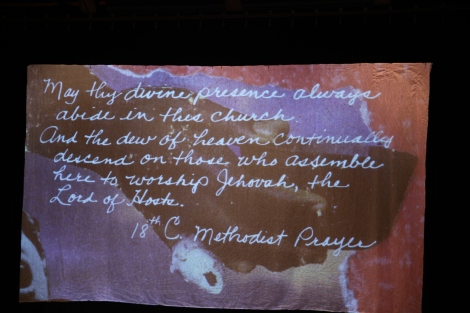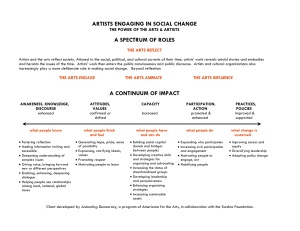
An 18th century Methodist prayer, part of the collage backdrop for Where Heaven’s Dew Divides. (Photo credit: Nathea Lee)
Other People’s Words
One of our rituals was bringing resonant and provocative text into our workshop space. Sometimes we arrayed them, gallery-style, and just let them live undiscussed in the studio. Sometimes we used them to seed dialog that opened the space for movement. Sometimes they were immediate stimuli for group exercises and movement experimentation. Sometimes they were integral to performance material. Here are some of our collected quotes.
About Rhythm…
A piece of music doesn’t move by the melody. It moves by the relationship of the harmonic structure to the rhythm.”
— Paraphrased from 2011 interview with Antonio Papano, Conductor and Musical Director of the Royal Opera HouseSilence is the perfect music. Musicians make an ornate frame for the perfect music.”
— Sting, 2010“The break is an unexpected, uncontrollable space where an insistent beat is interrupted by a flash of contradictory rhythmic ideas…it contains both the tie to a ubiquitous rhythmic flow and the potential for anarchy and disruption.”
— Thomas A. DeFrantz“Great storytelling can work in any medium. The component is almost always rhythm—-it’s a mysterious “X” factor. The challenge is to get to the deeper rhythm—the sound, the body, the act. The training is to let the material go through you—the actor, the singer…”
— Paraphrased from interview with director of Broadway production of Showboat.“I saw Sonny Rollins perform in Berkeley in 1977; he is one of the most melodic saxophone players of our time. Yet nearly thirty years later, while I can’t remember any of the pitches that he played, I clearly remember some of the rhythms. At one point, Rollins improvised for three and a half minutes by playing the same one note over and over again with different rhythms and subtle changes in timing. All that power in one note! It wasn’t his melodic innovation that got the crowd to their feet—it was rhythm.”
— Daniel J. Levitin, This Is Your Brain on Music (2006), 55.“Rhythm, meter, and tempo are related concepts that are often confused with one another. Rhythm refers to the length of notes, tempo refers to the pace of a piece of music (the rate at which you would tap your foot to it), and meter refers to when you tap your foot hard versus light, and how these hard and light taps group together to form larger units.”
— Daniel Levitin, This is Your Brain on Music, (2006) 55-56.
About History and Place…
No place is a place until things that have happened in it are remembered in history, ballads, yarns, legends, or monuments… No place is a place until it has had a poet.”
— Wallace Stegner“…but now the arc of imagination bends back to history, because it can’t compete with history. A black Hawaiian with a Swahili name? It’s the sort of history that puts novelists out of business.”
— Steve Erickson, These Dreams of You“History…does not refer merely to the past… history is literally present in all that we do.”
— James Baldwin, Unnamemable Objects, Unspeakable Crimes“Performance is tangible, vivid, real, touchable, knowable through the senses. Gesture, speech, song… is important to imagining history and feeling its importance.”
— Joe Roach, 2007 Hemispheric Institute interview“…emphasize the inward process of memory over the outward process of performance.”
— Katherine Profeta, from “Ralph Lemon and the Buck Dance”“What happens when we cannot tell our stories, when our memories have temporarily abandoned us? What is left is longing for something we are not even sure we ever had but are certain we will never experience again.”
— Edwidge Danticat, Create Dangerously: The Immigrant Artist at Work“I love how the dancing body is able compositionally…when successful…to bring the idea of time and knowledge transfer forward to viewing consciousness. Not didactically…but through the confrontation of bodies with each other, through touch, and the ways in which gestures may be made to echo across time.”
— Bill Bissell
About Dialogue and Collaboration
We know that the work itself will provide answers, more questions, of course, but also infinite ways of seeing, rethinking and imagining what we wouldn’t have arrived at otherwise….it is the process itself that answers questions.
— Wura-Natasha Ogunji (March 2013)Only within the open space created by dialogue, whether conducted with our neighbors, with history, with nature or the cosmos, can human wholeness be sustained. We are not born human in any but a biological sense; we can only learn to know ourselves and others and thus be trained in the ways of being human. We do this in the immersion of the ocean of language and dialogue fed by the springs of cultural tradition.”
— Daisaku Ikeda
About Art, Dance, and Improvisation
The purpose of art is to lay bare the questions that are hidden by the answers.”
— James Baldwin“Dance improvisation is spontaneous choreographic creation. What does it mean to come to the stage to interrogate that which you do not know and cannot predict?….Improvisation drives new creation, new practices, new questions. The unknown possibilities of “becoming” require mystery, mastery, intuition, rigor and wit.”
— Jawole Willa Jo Zollar“As a scientist uses a microscope to look at the world, a dancer [can] use the conscious body as a tool to probe into the nature of experience.”
— Daniel Lepkoff“It is dangerous for the arts when it becomes too big a risk to actually take a risk, to ask questions in public.”
— Daniel Lepkoff“As an artist, you have to manifest…. You don’t get to count what you haven’t done…the thoughts and ideas that you haven’t realized.”
— James Turrell
“To be awake on stage, to distort something—-a movement, a gesture, a word, a sentence—requires an act of necessary violence: violence of undefining. Undefining means removing the comfortable assumptions….What is instantly definable is instantly forgettable. Anything on stage can be asleep when it is overly defined.”
— Ann Bogart
A Continuum of Impact for Artists Engaging in Social Change
Selected Readings
“The Site of Memory” by Toni Morrison
Selected references for creation of Where Heaven’s Dew Divides
Andrews, William L., ed. Sisters of the Spirit: Three Black Women’s Autobiographies of the Nineteenth Century, Bloomington: Indiana University Press, 1986
Foster, Susan Leigh, ed. Choreographing History, Bloomington and Indianapolis: Indiana University Press, 1995
Harrison, Eliza Cope, ed. For Emancipation and Education: Some Black and Quaker Efforts 1680-1900, Philadelphia: Awbury Arboretum Association, 1997
Kowal, Rebekah J., How To Do Things with Dance: Performing Change in Postwar America, Middletown CT: Wesleyan University Press, 2010
Lincoln, C. Eric & Mamiya, Lawrence H., The Black Church in the African American Experience, Durham: Duke University Press, 1990
Nash, Gary B., Forging Freedom: The Formation of Philadelphia’s Black Community 1720-1840, Cambridge: Harvard University Press, 1988
Newman, Richard S., Freedom’s Prophet: Bishop Richard Allen, the AME Church, and the Black Founding Fathers, New York: New York University Press, 2008
Olick, Jeffrey K, Vinitsky-Seroussi, Vered, & Levy, Daniel, The Collective Memory Reader, Oxford: Oxford University Press, 2011
Roach, Joseph, Cities Of The Dead: Circum-Atlantic Performance, New York: Columbia University Press, 1996
Saltzman, Lisa, Making Memory Matter: Strategies of Remembrance in Contemporary Art, Chicago: University of Chicago Press, 2006
Tillet, Salamishah, Sites of Slavery: Citizenship and Racial Democracy In The Post-Civil Rights Imagination, Durham: Duke University Press, 2012
Wigger, John H., Taking Heaven by Storm: Methodism and the Rise of Popular Christianity in America, Urbana: University of Illinois Press, 1998
Winch, Julie, A Gentleman of Color: The Life of James Forten, Oxford: Oxford University Press, 2002

